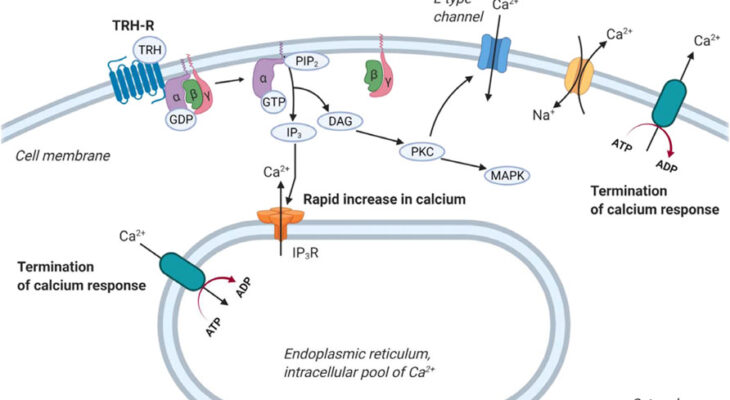The thyrotropin-releasing hormone (TRH), also known as Protirelin, is a peptide hormone composed of three amino acid residues. Synthesized in the hypothalamus, the region of the brain located above the pituitary gland, TRH is believed to play a key role in regulating the secretion of thyroid-stimulating hormone (TSH) and prolactin. Studies suggest that the TRH peptide might impact metabolic processes, and it has also been hypothesized to hold potential properties for various thyroid-related disorders. Notably, it currently needs to be investigated as a promising candidate for the context of conditions such as hypothyroidism and acromegaly. Where can you find Thyrotropin for sale in the USA? Let’s find out. Here, you’ll learn all you need to know about TRH.
TRH and Thyroid Research
Research indicates that TRH may trigger the secretion of thyrotropin, also referred to as thyroid-stimulating hormone (TSH), from the pituitary gland. This signaling cascade is thought to subsequently influence the thyroid gland’s development and functional capacity. Findings imply that TRH may play a critical regulatory role in the secretion of thyroxine and triiodothyronine, which are primary hormones controlling metabolic rate, neuromuscular activity, and other physiological functions. Studies suggest that these hormones may even be implicated in the regulation of cardiovascular function and thermoregulation.
In organisms, when the brain detects low thyroid hormone levels, it has been suggested that TRH may be released into the pituitary gland’s circulatory system, prompting the production of TSH. The feedback loop involving TRH and TSH thus maintains the homeostasis of thyroid hormones, highlighting TRH’s potential as a regulatory agent in thyroid function.
Potential Properties of TRH Peptide
- Depression
Researchers have long speculated that TRH may possess antidepressant qualities. Since the 1970s, a hypothesized link between TRH and mood regulation has led to ongoing research into the peptide’s potential neuropsychiatric applications. In a notable study, TRH was given to rodent models, resulting in significant reductions in depression-like behaviors. In five out of eight test subjects, these behavioral indicators of despair appeared reduced by nearly 50%. While the precise mechanisms remain under study, it is theorized that TRH might modulate neurotransmitter activity in a way that may have antidepressant impacts.
One limitation of TRH, however, appears to be its short half-life; thus, its antidepressant impact might be transient. Researchers speculate that nighttime exposure to TRH may align with the peptide’s inherent circadian rhythms, enhancing its antidepressant properties. Studies have indicated that Protirelin given during nighttime might potentially extend the peptide’s activity up to 48 hours, a finding that underscores the importance of exposure timing for sustained efficacy.
- Aging
Investigations purport that TRH may possess properties relevant to anti-aging, as suggested in experimental studies with rodents. Research suggests that TRH exposure may reduce the buildup of amyloid plaques, particularly in renal tissues. In aging rodents, TRH has been linked to a reduction in amyloid deposits, potentially preserving renal function over time. Similarly, TRH exposure has been associated with improved testicular function in older male rodents.
TRH and Thyroid Gland Activity
Scientific research has indicated that thyroid dysfunctions are associated with fluctuating TRH levels. Variations in TRH concentrations have been linked not only to primary thyroid diseases but also to non-thyroidal illnesses. Some studies propose that these variations may arise from altered neuronal pathways in the brain, which either fail to produce sufficient TRH or become unresponsive to feedback systems. Such alterations in TRH synthesis or reception could have implications for the broader regulation of endocrine functions.
Future Research Directions
Future studies are expected to delve deeper into TRH’s anti-free radical properties, with an emphasis on its potential role in reducing oxidative stress and modulating age-related cellular damage. Furthermore, TRH’s role in amyloid regulation could yield novel insights into the context of neurodegenerative disorders. At the same time, its endocrine-regulatory properties may support broader applications in metabolic and non-thyroidal illness contexts.
In conclusion, thyrotropin-releasing hormone (TRH) represents a promising field of study in peptide-based agents. With its potential impact on thyroid regulation, mood disorders, and age-associated conditions, TRH continues to be a focal point for scientific inquiry. Ongoing investigations are likely to reveal further applications, helping to clarify the full spectrum of TRH’s physiological impacts and research possibilities.

